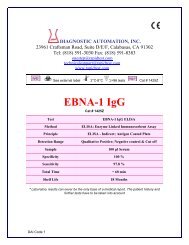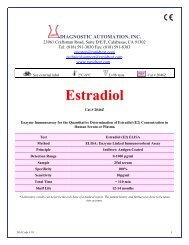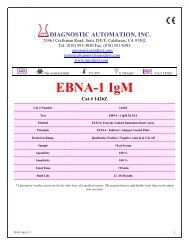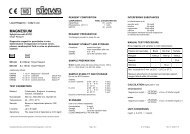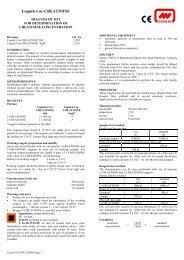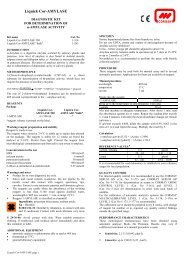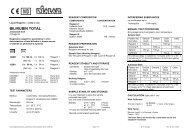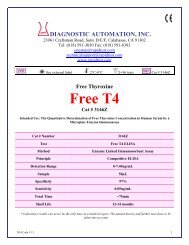CORMAY CUP Latex
CORMAY CUP Latex
CORMAY CUP Latex
You also want an ePaper? Increase the reach of your titles
YUMPU automatically turns print PDFs into web optimized ePapers that Google loves.
<strong>CORMAY</strong> CRP <strong>Latex</strong><br />
AGGLUTINATION TEST<br />
FOR DETECTION OF<br />
C-REACTIVE PROTEIN (CRP)<br />
Kit name Kit size Cat. No<br />
<strong>CORMAY</strong> CRP <strong>Latex</strong> 100 100 tests 6-254<br />
INTRODUCTION<br />
C-Reactive protein (CRP) is an acute-phase α1-globulin synthesized<br />
by hepatocytes. The level of CRP can rise up to more than 20 times<br />
in association with acute inflammation. High CRP levels can be<br />
detected within 24 hours of the onset of the acute phase and the peak<br />
serum concentration is achieved within 48 hours. After an<br />
inflammatory stimulus, the release of cytokines induces a varity of<br />
genes to help control infection. One class of such genes is that of<br />
carbohydrate-binding proteins to which pertains CRP. In the present<br />
of calcium ions, the protein binds carbohydrates present on the<br />
membrane of many bacteria.<br />
The detection of CRP is useful in detecting inflammation and in<br />
monitoring its progress or response to treatment.<br />
METHOD PRINCIPLE<br />
<strong>Latex</strong> particles coated with goat IgG anti-human CRP are<br />
agglutinated when mixed with samples containing CRP.<br />
REAGENTS<br />
Package<br />
CRP-<strong>Latex</strong><br />
CRP- Control (+) (red cap)<br />
CRP-Control (-) (blue cap)<br />
Stirrers<br />
Slides (6 circles each)<br />
<strong>CORMAY</strong><br />
CRP <strong>Latex</strong> 100<br />
1 x 5 ml<br />
1 x 1 ml<br />
1 x 1 ml<br />
2 x 25 pcs.<br />
2 x 9 pcs.<br />
Reagent preparation and stability<br />
The reagents are ready to use.<br />
The reagents when stored at 2-8C are stable up to expiry date<br />
printed on the package. Do not freeze.<br />
Always keep vials in vertical position. If stored in different position<br />
gently mix to dissolve aggregates that may be present.<br />
Concentrations in the test<br />
latex particles coated with goat IgG anti-human CRP<br />
human serum solution<br />
animal serum solution<br />
preservative<br />
50 mmol/l<br />
150 mmol/l<br />
150 mmol/l<br />
Warnings and notes<br />
• Product for in vitro diagnostic use only.<br />
• The reagents must be used only for the purpose intended by<br />
suitably qualified laboratory personnel, under appropriate<br />
laboratory conditions.<br />
• Components from human origin have been tested and found to<br />
be negative for the presence of HBsAg, HCV, and antibody to<br />
HIV (1/2). However handle cautiously as potentially infectious.<br />
• The reagents contain sodium azide (< 0.1%) as a preservative.<br />
Avoid contact with skin and mucous membranes.<br />
• High CRP concentration samples may give negative results. Retest<br />
the sample again using a drop of 20 µl.<br />
• Diagnosis should only be made after taking clinical symptoms<br />
and the results of other tests into consideration.<br />
ADDITIONAL EQUIPMENT<br />
• mechanical rotator with adjustable speed at 80-100 r.p.m.<br />
• general laboratory equipment.<br />
SPECIMEN<br />
Serum. Stable 7 days at 2-8ºC or 3 months at –20ºC.<br />
Samples with presence of fibrin should be centrifuged.<br />
Do not use highly hemolized or lipemic samples.<br />
It is recommended to perform the assay with freshly collected<br />
samples.<br />
PROCEDURE<br />
The test is recommended for the qualitative and semi-quantitative<br />
manual assays.<br />
Qualitative method<br />
1. Allow the reagents and samples to reach room temperature. The<br />
sensitivity of the test may be reduced at low temperatures.<br />
2. Place 50 µl of the sample and one drop of each positive and<br />
negative controls into separate circles on the slide test.<br />
3. Mix the CRP-<strong>Latex</strong> reagent vigorously before using and add one<br />
drop (50 µl) next to the sample to be tested.<br />
4. Mix the drops with a stirrer, spreading them over the entire surface<br />
of the circle. Use different stirrers for each sample.<br />
5. Place the slide on a mechanical rotator at 80-100 r.p.m. for 2<br />
minutes. False positive results could appear if the test is read later<br />
than two minutes.<br />
Reading and interpretation<br />
Examine macroscopically the presence or absence of visible<br />
agglutination immediately after removing the slide from the rotator.<br />
The presence of agglutination indicates a CRP concentration equal or<br />
greater than 6 mg/l.<br />
Semi-quantitative method<br />
1. Make serial two fold dilutions of the sample in 0.9% NaCl<br />
solution.<br />
2. Proceed for each dilution as in the qualitative method.<br />
Reading and interpretation<br />
The result (titer), in the semi-quantitative method, is defined as the<br />
highest dilution showing a positive result.<br />
The approximate CRP concentration in the patient sample is<br />
calculated as follows:<br />
CRP concentration (mg/l) = 6 x the highest dilution<br />
REFERENCE VALUES<br />
adults<br />
< 6 mg/l<br />
It is recommended for each laboratory to establish its own reference<br />
ranges for local population.<br />
QUALITY CONTROL<br />
Positive and negative controls are recommended to monitor the<br />
performance of the procedure, as well as a comparative pattern for<br />
a better result interpretation.<br />
Any result different from negative control result will be considered<br />
as positive.<br />
PERFORMANCE CHARACTERISTICS<br />
• Analytical sensitivity: 6 (5-10) mg/l.<br />
• Prozone effect: no prozone effect up to 1600 mg/l.<br />
• Diagnostic sensitivity: 95.6 %.<br />
• Diagnostic specificity: 96.2 %.<br />
• Interferences:<br />
Haemoglobin up to 10 g/l, bilirubin up to 20 mg/dl, triglycerides<br />
up to 10 g/l and RF up to 100 U/ml do not interfere with the test.<br />
<strong>CORMAY</strong> CRP <strong>Latex</strong> page 1
WASTE MANAGEMENT<br />
Please refer to local legal requirements.<br />
LITERATURE<br />
1. Lars-Olof Hanson et al. Current Opinion in Infectious diseases<br />
1997; 10: 196-201.<br />
2. M.M. Pepys. The Lancet 1981; March 21: 653 – 656.<br />
3. Chetana Vaishnavi. Immunology and Infectious Diseases 1996; 6:<br />
139 – 144<br />
4. Yoshitsugy Hokama et al. Journal of Clinical Laboratory Status<br />
1987; 1: 15 – 27.<br />
5. Yamamoto S et al. Veterinary Immunology and Immunopathology<br />
1993; 36: 257 – 264.<br />
6. Charles Wadsworth et al. Clinica Chimica Acta; 1984: 138: 309 –<br />
318.<br />
7. Young DS. Effects of drugs on clinical laboratory test, 4th ed.<br />
AACC Press, 1995.<br />
Date of issue: 07. 2013.<br />
MANUFACTURER<br />
PZ <strong>CORMAY</strong> S.A.<br />
22 Wiosenna Street,<br />
05-092 Łomianki, POLAND<br />
tel.: +48 (0) 22 751 79 10<br />
fax: +48 (0) 22 751 79 14<br />
http://www.cormay.pl<br />
<strong>CORMAY</strong> CRP <strong>Latex</strong> page 2<br />
07/13/07/13






